Things to do in Mexico City
The culturally colourful and historically fascinating Mexico City has plenty to see and do for visitors from all walks of life. The city is well worth exploring en route to the resorts, and is a great place for a lively weekend away or even a holiday destination in its own right. Mexico City is also reputed to be the city with the most museums in the world and is sure to appeal to history buffs and art lovers.
With ancient ruins just a stone's throw from the city, tourists will want to visit the Templo Mayor, the principal temple of the Aztecs and part of Tenochtitlán, as well as the UNESCO World Heritage Site of Teotihuacan, which is the site of Mexico's largest ancient city and dates back to around 300 to 600 BC. For a more colonial flavour, travellers should visit the beautiful nearby town of Guanajuato, discovered by the Spanish in 1558 for its silver deposits.
Downtown Mexico City is a great place to soak up the architecture and atmosphere of the stately buildings. The Zócalo is the main gathering point in the city and is surrounded by historic buildings. The Plaza Garibaldi-Mariachi is surrounded by cafés and restaurants and is also a favourite spot for tourists. To see the city at its most picturesque, visitors should stroll along the cobbled streets of San Angel where ancient mansions and colonial houses make for wonderful photo opportunities.
Art lovers will enjoy the Palacio de Bellas Artes, which features the works of Diego Rivera and David Alfaro Siqueiros, as well as 6,000 other works of art. Another of Mexico City's most popular attractions is undoubtedly the Bosque de Chapultepe. It's the destination's largest park and covers an enormous area containing lakes, a zoo and several museums, including the Museo Nacional de Antropología.
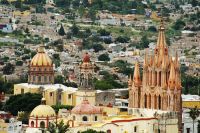
San Miguel de Allende
San Miguel de Allende has retained its historical charm with beautiful 17th- and 18-century Baroque buildings. Narrow cobbled lanes are framed by yellow, orange and ochre buildings…
San Miguel de Allende
San Miguel de Allende has retained its historical charm with beautiful 17th- and 18-century Baroque buildings. Narrow cobbled lanes are framed by yellow, orange and ochre buildings covered with bougainvillea vines. The city has a number of beautiful buildings including the pink Gothic parish church of La Parroquia, the magnificent Centro Cultural Ignacio Ramiez and the richly-decorated Oratorio de San Felipe Neri Church. A centre of Bohemian creativity in the 20th century, San Miguel de Allende is very popular with foreign expats and tourists in Mexico, having been noted as a desirable retirement destination for Americans. San Miguel de Allende also has a lively arts community, with productions hosted regularly at the Angela Peralta Theatre and the Otra Cara de México. The city is a three and a half hour drive from Mexico City.
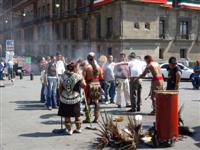
El Zocalo
The enormous paved Plaza de la Constitución, or Zocalo, is the second largest city square in the world. Dominated on one side by the magnificent colonial Presidential Palace, and …
El Zocalo
The enormous paved Plaza de la Constitución, or Zocalo, is the second largest city square in the world. Dominated on one side by the magnificent colonial Presidential Palace, and on the other by the great Metropolitan Cathedral with its ornate interior, the square is Mexico City's centre of government and religion. The square itself is always filled with activity, with vendors, buskers and informal performances and passing tourists. Every evening the presidential guards lower the national flag from the central flagpole. The square is constantly encircled by the city's ubiquitous green Volkswagen taxis and is a good starting point for those wanting to explore the city.
Templo Mayor
Templo Mayor was the principal temple of the Aztecs, believed to mark the centre of the universe. It was part of the sacred complex of the ancient city of Tenochtitlan, and today i…
Templo Mayor
Templo Mayor was the principal temple of the Aztecs, believed to mark the centre of the universe. It was part of the sacred complex of the ancient city of Tenochtitlan, and today it has been excavated to show the multiple layers of construction. The temple was first built in 1375 and enlarged several times, each rebuilding accompanied by a bloody sacrifice of captured warriors to rededicate the sacred area. Within the site is the excellent Museo del Templo Mayor, displaying artefacts from the original site including a great wheel-like stone carving of the Aztec goddess of the moon, Coyilxauhqui.
Website www.templomayor.inah.gob.mx/english
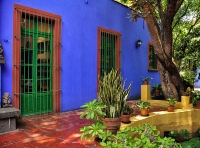
San Angel
Formerly a separate village, San Angel is one of the more charming of Mexico's suburbs, an exclusive neighbourhood with ancient mansions and colonial houses along cobbled streets. …
San Angel
Formerly a separate village, San Angel is one of the more charming of Mexico's suburbs, an exclusive neighbourhood with ancient mansions and colonial houses along cobbled streets. It's famed for its Saturday craft market in the pretty Plaza San Jacinto, which brings colour, crowds and a festive atmosphere to the area, and has excellent art and handicrafts for sale. The suburb is crammed with little restaurants and cafes, several museums exhibiting the works of Frida Kahlo and others, and the lovely El Carmen complex consisting of a triple-domed church, a former monastery and a museum. San Angel is surrounded by a volcanic rock bed called the Pedregal. Parts of this unusual landscape have been declared protected areas where visitors can see the endemic flora and fauna.
Zona Rosa
The Zona Rosa (Pink Zone) is Mexico City's major dining, nightlife and shopping district, crammed with bars, shops, boutiques, restaurants and hotels. The district has subtly shift…
Zona Rosa
The Zona Rosa (Pink Zone) is Mexico City's major dining, nightlife and shopping district, crammed with bars, shops, boutiques, restaurants and hotels. The district has subtly shifted in its appeal recently. Once a fashionable hub for youth and the upper classes, the Zona Rosa is now also frequented by the city's gay community and tourists. The symbol of Mexico City, a gilded statue of Winged Victory, looms above the district and is one of the city's most photographic features. There is accomodation available in the area, but visitors are advised that it can be noisy at night.
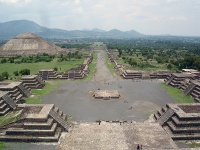
Teotihuacan
Situated 31 miles (50km) from Mexico City, the UNESCO World Heritage Site of Teotihuacan is the country's largest ancient city, dating from around 300 to 600 BC. Legend has it the …
Teotihuacan
Situated 31 miles (50km) from Mexico City, the UNESCO World Heritage Site of Teotihuacan is the country's largest ancient city, dating from around 300 to 600 BC. Legend has it the Aztecs found the abandoned city, recognising signs of its previous magnificence and naming it Teotihuacan (Place of the Gods). The central thoroughfare of Teotihuacan is the Avenue of the Dead, a 1,3 mile (2km) stretch connecting the three main attractions. The Pyramid of the Sun is the third largest in the world, a huge red painted structure over a cave with spectacular views from the top. The smaller, more graceful Pyramid of the Moon contains an altar believed to have been used for religious dancing. The Citadel is a large square complex that was once the residence of the city's ruler. Within the walls is its main feature, the Templo de Quetzalcoatl.
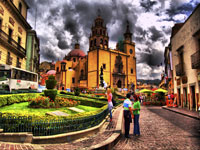
Guanajuato
Guanajuato is a colonial gem, founded around the rich silver deposits discovered by the Spanish in 1558. The city has an unusual layout, crammed into a narrow valley with houses an…
Guanajuato
Guanajuato is a colonial gem, founded around the rich silver deposits discovered by the Spanish in 1558. The city has an unusual layout, crammed into a narrow valley with houses and streets forced into irregular positions due to the naturally hilly topography. Brightly painted houses perch on slopes reached by narrow cobbled alleyways, hidden plazas, steep stairways and underground tunnels. The most narrow, and most visited, alley is the Callejón del Beso (Alley of the Kiss) where the balconies of the leaning houses on either side almost touch each other, a feature in the local romantic legend about furtive lovers exchanging kisses. Every weekend the famous strolling musicians lead processions through the narrow winding alleyways, strumming, singing and telling stories to following crowds.
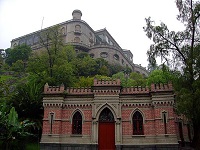
Bosque de Chapultepec
Bosque de Chapultepec is a truly immense urban park. Mexico's answer to Central Park spans over 686 hectares (1,695 acres), and on any given day is brimming with people. The park i…
Bosque de Chapultepec
Bosque de Chapultepec is a truly immense urban park. Mexico's answer to Central Park spans over 686 hectares (1,695 acres), and on any given day is brimming with people. The park is home to boating lakes, monuments, a zoo, playing fields, and Chapultepec Castle. The castle stands on a hill in the centre of the park, housing the Natural History Museum and offering incredible views of the city. There's plenty to see and do in the park, but most people come to relax on lunch breaks or weekends.



